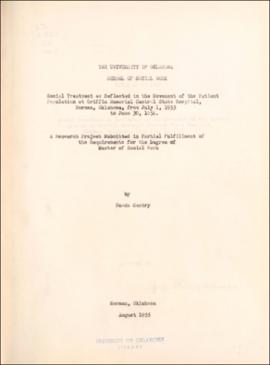| dc.contributor.author | Gentry, Wanda | |
| dc.coverage.spatial | Oklahoma | |
| dc.date.accessioned | 2022-02-15T14:47:07Z | |
| dc.date.available | 2022-02-15T14:47:07Z | |
| dc.date.created | 1955 | |
| dc.date.issued | 1955 | |
| dc.identifier.uri | https://hdl.handle.net/11244/334594 | |
| dc.description | Thesis (M. Soc. Work.)--University of Oklahoma, 1955. | |
| dc.description | Includes bibliographical references (leaves 92-93) | |
| dc.description.abstract | Mental health has assumed a very serious aspect over the entire nation during recent years. Oklahoma has made provision for its mentally ill people since statehood. In this study, data on admissions, resident patients, and releases from Central State Hospital have been studied in an attempt to show factors which influence movement of the patient population.
Twenty tables of data have been used in the study, to show trends in movement. Tables on the number and type of personnel have also been included as factors influencing the rate of movement of the patient population. Central State Hospital had almost half the total admissions to mental hospitals in the state for the year July 1, 1953 through June 30, 1954. In the counties having a high proportion of people sixty-five years of age and over, the admissions to mental hospitals were relatively higher than in counties having a smaller proportion sixty-five and over. In 1948 Oklahoma hospitals admitted a higher percent of persons seventy years of age and over per 100,000 of the general population than the United States as a whole.
The resident population of Central State Hospital has more persons in the 45-59 age group than in any other five year age group. The types of mental illnesses common to this age group require longer periods of hospitalization than the others. The number of patients on convalescent leave from Central State Hospital conformed to a seasonal trend. The number on leave was larger in the spring and early summer than at any other time of the year. Bed capacity in Central State Hospital was adequate but in other state hospitals the bed capacity was far below the requirements. All hospitals were in need of more trained personnel. Central State had only 44.4 percent of the psychiatrists needed, 36.1 percent of the psychologists needed and 9.1 percent of the social workers needed. The mental illnesses most frequently found in Central State Hospital and in the United States in general are psychoneuroses manic depressive psychosis, and dementia praecox. | |
| dc.format.extent | vii, 93 leaves | |
| dc.format.medium | vii, 93 leaves ; 29 cm. | |
| dc.language.iso | eng | |
| dc.subject | Mental illness--Treatment--Oklahoma | |
| dc.title | Social treatment as reflected in the movement of the patient population at Griffin Memorial Central State Hospital, Norman, Oklahoma, from July 1, 1953 to June 30, 1954 | |
| dc.type | Text | |
| ou.group | School of Social Work | |
